Fujian Province is located between the southeast coast of continental China and the west coast of Taiwan Strait. The tortuous coastline is over 3,000 kilometers long and forms numerous harbors. As an unavoidable section of the Maritime Silk Road during its history of over a thousand years, the coastal area of Fujian Province has been abundant in underwater cultural heritage deposits, making Fujian Province a good place for advancing underwater archaeology.
Underwater archaeological work in Fujian Province began in the late 1980s. The National Museum of Chinese History [currently The National Museum of China – Trans.] and other organizations conducted a preliminary investigation into a Song Dynasty shipwreck site at Baijiao [lit. “White Reef”] Reef No. 1, located near Dinghai Village in Lianjiang County. Thereafter, systemic underwater archeology surveys were carried out successively in Fujian Province, and 30 cultural heritage remains were discovered. These sites are mainly located in the coastal areas of Fuzhou City, Putian City, Zhangzhou City and other coastal areas.
This paper will introduce important underwater cultural heritage remains that have been discovered in underwater archaeological surveys since 2008, and will analyze their cultural contents, spread and distribution, etc.
LOCATIONS AND CONTENTS OF THE UNDERWATER CULTURAL HERITAGE REMAINS
The underwater cultural heritage remains in the coastal area of Fuzhou City are mainly located in Haitan Strait in Pingtan County. Haitan Strait, located between the mainland and Haitan Island, is about 40 km long, 3.3 km to 10 km wide, and five to 30 meters deep.[1] The underwater cultural heritage remains in the coastal area of Putian City are mainly located in the coastal areas of Nanri Island to Meizhou Bay and Xinghua Bay. The underwater cultural heritage remains in the coastal area of Zhangzhou City are located in the coastal areas of Banyang Reef in Zhangpu County, Gulei Peninsula and Dongshan Island. Geographically, the sea route through the coastal areas from Haitan Strait via Nanri Island, Meizhou Bay and Xinghua Bay, and as far as Dongshan Island, forms an important part of the Maritime Silk Road that controlled north-south traffic from ancient times. In addition, this area is prone to maritime accidents due to numerous harbors, headlands and reefs, and complicated sea conditions. Hence, these coastal areas contain abundant underwater cultural heritage remains, and have become the key region of underwater archaeological work in China.
(A) The Song Dynasty Shipwreck Site Near Xinan Islet of Dalian Island in Pingtan County
This site is located southwest of Xinan Islet, north of Dalian Island. The water depth is about 35 m at low tide. Most of the seabed in the area is rocky, and parts of the low-lying places contain silt deposits. The Underwater Archaeological Survey Team for the Coastal Area of Fujian Province investigated this site from 2009 to 2010, and recovered a number of artifacts, all of which were celadon porcelain wares of the styles of Longquan kilns. These artifacts consist of mainly wan-bowls, followed by pan-plates, die-saucers and other items.

shipwreck site near Xi’nan Islet of Dalian Island in Pingtan County. 1, 2. Wan-bowls (XNY:02, 04) 3. Die-saucer (XNY:06) 4. Pan-plate (XNY:10) (scale 1:4)
Celadon wan-bowls: These bowls have round lips, flaring or slightly everted mouths, deep arc bellies, flat bottoms and ring feet with slanting bottom ends on both sides. They have gray porcelain bodies with heavy texture and, except in the center of the ring foot, are fully glazed inside and outside with a matcha-greenish celadon glaze with a brownish undertone. Artifacts include the following: Artifact XNY:04 has lotuses and water ripples carved on its interior wall and bottom. Its mouth diameter is 15.9 cm, ring foot diameter 5.7 cm and height 6.5 cm (Figure 1:2; Figures 7 and 33). Artifact XNY:02 has lotuses and water ripples carved on its interior wall and bottom. Its exterior is incised with a folding fan pattern. Its mouth diameter is 18.9 cm, ring foot diameter 6.8 cm and height 8.2 cm (Figure 1:1).
Celadon pan-plate: Artifact XNY:10 has a round lip, slightly everted mouth, slant straight belly with a slight curve, relatively flat bottom, and short, thick ring foot. The gray porcelain body is rather thick. The entire pan-pate, except for its unglazed base and the inside of the ring foot, is coated with sallow celadon glaze inside and outside. Parts of the pan-plate have crackles. This pan-plate has lotuses and water ripples carved on its interior wall and bottom. Its exterior is incised with a folding fan pattern. Its mouth diameter is 18.5 cm, ring foot diameter 6.3 cm and height 5 cm (Figure 1:4; Figures 5 and 6).
Celadon die-saucer: Artifact XNY:06 has a round lip, flaring mouth, everted belly and concave bottom. It has a gray porcelain body and is fully glazed inside and outside with a sallow celadon glaze with a brownish undertone, except for its exterior bottom. Parts of the die-saucer have crackles. A lotus bud decorates the interior bottom. Its mouth diameter is 13.7 cm, ring foot diameter 4.5 cm and height 3.7 cm (Figure 1:3).
These recovered artifacts are neatly crafted, with delicate craftsmanship in porcelain body shaping and glaze application; their decorations are well organized and meticulously incised. These porcelain artifacts are similar to the products of the Huichang kilns in Songxi County and the Wan and Bei kilns in Pucheng County of northern Fujian Province, and should be dated to the early Southern Song dynasty.
(B) Qing Dynasty Underwater Cultural Heritage Site at Wanjiao Reef Locus No. 2 in Pingtan County
This site is located in the southeast of Wanjiao [lit. “Bowl Reef”]Reef, about 1,000 m from the Wanjiao Reef Locus No. 1 shipwreck site. The water depth is 6 m to 8 m at low tide. The seabed is rocky in the eastern and southern areas of the site, and sandy in the western and northern areas. The archaeology survey team carried out an investigation at this site in 2010, and recovered a number of artifacts, primarily blue and white porcelain wares, including wan-bowls, pan-plates, bei-cups and brush pen holders.
Blue and white wan-bowl: Artifact WJ-2:20 has a round lip, slightly everted mouth, deep arc belly, slightly arced inner bottom, flat exterior bottom, and a tall, round ring foot. It has a fine and smooth white porcelain body. It is fully glazed both inside and outside, except for its ring foot end. Double underglaze blue lines are painted on the interior of the rim and lower interior wall respectively, and the interior bottom is painted with a chrysanthemum-flower pattern. Double underglaze blue lines are painted on the exterior of the rim and exterior wall of the ring foot; a band of single underglaze blue line is also painted at the demarcation of the belly and ring foot. The exterior wall is painted with a dragon-and-phoenix pattern and chrysanthemum-flower pattern; the exterior bottom is painted with a double underglaze blue line circle with underglaze blue decorative pattern in the center, and the underglaze blue paint shows a blue color with a grayish undertone. Its mouth diameter is 15.1 cm, ring foot diameter 6.7 cm and height 8.1 cm (Figure 2:3 and Figure 8).
Blue and white pan-plate: Artifact WJ-2:33 has a round lip, flaring mouth, slant arc belly, concave inner bottom, flat outer bottom, large ring foot with thick wall, and a slanting outer end. It has a white porcelain body with a grayish undertone and a scraped unglazed circle at the inner bottom. The pan-plate is glazed to the lower belly on its exterior. Two bands of the transformed character 寿 (shou, meaning longevity) are painted on the interior wall, and a square logo seal is incised on the interior bottom; three flowers are painted on the upper portion of the exterior wall. The underglaze blue shows a blue color with a grayish undertone. Its mouth diameter is 23 cm, ring foot diameter 11.7 cm and height 5.1 cm.
Blue and white bei-cups: Artifact WJ-2:18 has a round lip, slightly everted mouth, deep arc belly, rather flat bottom and contracted, round ring foot. It is coated with white paste and glazed both inside and outside, except on the bottom of the ring foot. Double underglaze blue lines are painted on the interior of the rim and the interior bottom. An image of a lone old fisherman is painted on the interior bottom. Double underglaze blue lines are painted on the exterior of the rim and the exterior wall of the ring foot; a band of single underglaze blue line is also painted at the demarcation of the belly and ring foot. The exterior wall is painted with an image of a “happy fishing family”; the exterior bottom is painted with a double underglaze blue line circle with underglaze blue seal in the center, and the underglaze blue paint shows a blue color with a grayish undertone. Its mouth diameter is 7.9 cm, ring foot diameter 4.3 cm and height 4.3 cm (Figure 2:1 and Figure 9). Artifact WJ-2:21 has a round lip, straight mouth, deep arc belly, slightly curved interior bottom, flat outer bottom and a tall, round ring foot. It has a white porcelain body, and is glazed both inside and outside, except on the bottom of the ring foot. The interior bottom is painted with a rocks-and-leaf design. The exterior of the rim and exterior wall of the ring foot are painted with double underglaze blue lines, and the exterior wall is painted with a rocks-and-flowers design with butterflies in underglaze blue; the exterior bottom is painted with a double underglaze blue line circle with underglaze blue seal in the center, and the underglaze blue paint shows a blue color with a grayish undertone. Its mouth diameter is 5.9 cm, ring foot diameter 2.7 cm and height 4.6 cm (Figure 2:2 and Figure 10).
Blue and white brush pen holder: Artifact WJ-2:35 has a round lip, straight mouth, cylindrical belly and short ring foot. It has a white porcelain body and is glazed both inside and outside, with the glaze scraped at the rim and the bottom of the ring foot. Triangle-framed panels with a lotus-flower pattern on underglaze blue background are painted on both upper and lower parts of the exterior wall, with an irregular pattern between the triangular frames. An underglaze blue double line pattern is painted near the edge of the outer bottom and on the interior wall of the ring foot. The artifact’s mouth diameter is 15 cm, ring foot diameter 9.7 cm and height 12.5 cm (Figure 2:4).
These recovered porcelain wares are products of the Jingdezhen kilns, as well as the kilns in Dehua, Anxi, and Hua’an counties, Fujian Province. Products from the Jingdezhen kilns are similar to the porcelain wares recovered from Wanjiao Reef Locus No. 1, which dates to the late seventeenth century, specifically to the middle years of Emperor Kangxi’s reign.[2] Products from the kilns of Fujian Province have also been recovered in the wreck of the Qing Dynasty merchant ship Taixing, which was salvaged in the South China Sea. Taixing sank in the second year of Emperor Daoguang’s reign during the Qing Dynasty (1822 CE),[3] so these recovered porcelain products should be dated to the late Qing Dynasty.
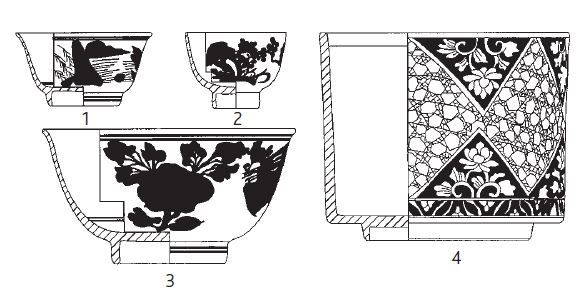
(C) Ming Dynasty Shipwreck Site Near Jiuliang Coastal Area in Pingtan County
This site is located on the east slope of the east waterway of Yutou Island in Pingtan County, where the water depth is 18 m at high tide. The seabed has a reef bottom. The eastern area of the site is 2.5 m higher than its western area. Archaeological surveys were conducted in 2006, and in 2008-2009, and a number of artifacts were recovered. Survey results for 2006 have been published.[4] Findings of the 2008-2009 investigation are introduced below.
A majority of the recovered artifacts are blue and white porcelain wares, followed by a small number of famille verte, blue and white underglaze, red and bluish-white porcelain wares. Types of porcelain wares include wan-bowls, pan-plates, stem bei-cups, guan-jars and other wares.
Blue and white wan-bowls: Artifact LB (Longhai Museum):4015 has a round lip, flaring mouth, slant arc belly, ring foot with thin wall, and straight wall both inside and outside. The wan-bowl has a flat inner bottom and a slightly convex outer bottom. It has a white porcelain body with slightly bluish glaze that is glazed both inside and outside. A band of pine-needle pattern is painted on the interior side of the rim. A band of pine-needle pattern is also painted on the inner bottom, encircling four underglaze blue characters in standard script, 永乐年制 (Yonglennianzhi, meaning “Made during Emperor Yongle’s Reign”). Its exterior wall contains a narrative story scene and texts. Its mouth diameter is 16.2 cm, ring foot diameter 7.7 cm and height 7 cm (Figure 3:1). Artifact LB:391 has a sharp lip, flaring mouth, slant arc belly, convex bottom, ring foot with slant walls both inside and outside and a sharp end. It has a white porcelain body with slightly bluish glaze that is glazed both inside and outside. Its underglaze blue shows a bright color. A double underglaze blue line pattern is painted on the interior of the rim with a band of flower-and-leaf pattern between the double line pattern. A flower-and-grass pattern is painted in the center of the encircled underglaze blue double line pattern. A dragon-and-phoenix pattern is painted on the exterior wall below the underglaze blue double line pattern on the exterior side of the rim. A single band of underglaze blue line pattern is painted at the end of the ring foot wall. Its mouth diameter is 14.1 cm, ring foot diameter 6.4 cm and height 6.2 cm (Figure 3:2 and Figure 11).
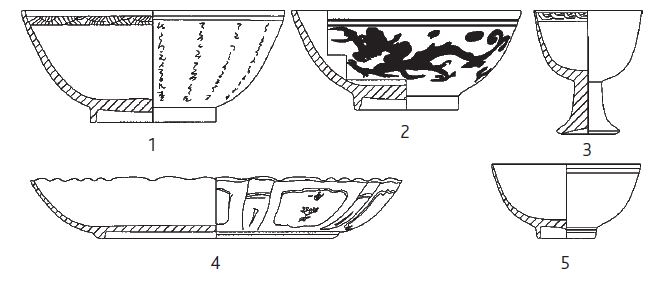
near Jiuliang coastal area in Pingtan County. 1, 2. Blue and white wan-bowls (LB:4015, 391) 3. Blue and white stemmed bei-cup with blue glaze (JL:22) 4. Blue and white pan-plate
(LB:354) t 5. Blue and white with underglaze red wan-bowl (JL:10) (4 scaled 1:8; the rest 1:4)
Blue and white pan-plate: Artifact LB:354 has a square lip, rhomboid flower mouth, slant arc belly, and a ring foot with slant outer wall and straight inner wall. It has a white porcelain body. It is glazed both inside and outside with the glaze scraped at the bottom of its ring foot. The interior wall is painted with eight framed panels enclosing paintings of flowers and birds. A double underglaze blue line pattern is painted on the interior bottom with paintings of flowers and rocks in its center. The exterior wall is painted with eight framed panels enclosing paintings of flowers. The plate’s mouth diameter is 46 cm, ring foot diameter 29 cm and height 7.6 cm (Figure 3:4).
Blue and white with underglaze red wan-bowl: Artifact JL (Jiuliang Site):10 has a round lip, flaring mouth, slant arc belly, slightly convex bottom, and a slightly contracted ring foot with thin wall. It has a fine and smooth white porcelain body. It is glazed both inside and outside except for the bottom of its ring foot. The exterior wall is painted with three sets of underglaze blue with underglaze red flowers. The underglaze blue shows blue color with a grayish undertone. Its mouth diameter is 9.1 cm, ring foot diameter 3.6 cm and height 4.6 cm (Figure 3:5 and Figure 12).
Blue and white stemmed bei-cup with blue glaze: Artifact JL:22 has a round lip, flaring mouth, deep arc belly, relatively flat inner bottom and a trumpet-shaped tall ring foot. It has a white porcelain body, and is fully glazed both inside and outside except for the bottom of the ring foot. The upper part of the interior wall is painted with a band of underglaze blue swirl grass pattern. The underglaze blue shows bluish-black color. The exterior wall is glazed with blue glaze. Its mouth diameter is 6.6 cm, ring foot diameter 3.7 cm and height 7.7 cm (Figure 3:3 and Figure 13).
Most of the porcelain wares recovered from this site are products of Jingdezhen kilns. Among the porcelain wares, the blue and white pan-plate (LB:354) is commonly known as “Kraak porcelain,” examples of which have been discovered in large numbers abroad and in shipwrecks, and which were the dominant variety of exported porcelain wares in the late Ming Dynasty. The discovery of this site has significance for research into the export routes of Jingdezhen porcelain wares.
(D) Underwater Cultural Heritage Site of the Song to Qing Dynasties Near Dongjiao Village on Xiaolian Island in Pingtan County
This cultural heritage site is located east of Dongjiao [lit. “East Reef”] Village on Xiaolian Island in Pingtan County. The water depth is 19 m to 21 m at low tide. The northeastern area has a silt seabed, and the rest of the area has a reef bottom. The cultural heritage remains are distributed over more than 1,000 square meters. The site was discovered during an archaeological survey in 2008, and a number of artifacts were recovered during a more comprehensive investigation in 2009. Artifacts recovered consist of predominantly pottery guan-jars and ping-vases, followed by celadon, greenish-white glaze, brown glaze, blue and white porcelain wares and others.
Celadon wan-bowl: Artifact XLD (Xiaolian Island):72 has a slightly contracted flaring mouth, slant arc belly, convex outer bottom and a ring foot. It has a gray porcelain body that is glazed with grayish-white glaze both inside and outside, except for the bottom of its ring foot. A lotus-petals-with-protruding-ridges pattern is carved on the exterior wall. Its mouth diameter is 17 cm, ring foot diameter 4.5 cm and height 7.2 cm (Figure 4:1).
Celadon ping-vase: Artifact XLD:54 has a round lip, slightly flaring mouth, sloped shoulder with a pair of horizontal bridge-shaped lugs, deep arc belly and a concave bottom. It has a gray porcelain body with bluish-gray glaze. Its interior is fully glazed and the exterior is glazed to the lower belly. Its mouth diameter is 5.1 cm, ring foot diameter 6 cm and height 20 cm (Figure 4:3).
Bluish-white zhihu-ewer: Artifact XLD:88 has a sharp lip, a slightly curled rim, a slightly everted mouth, long neck, everted shoulder, flat strip curved handle (with two lines of grooves on its surface) attached to the neck and shoulder, arc belly and a ring foot. It has a gray porcelain body with bluish-gray glaze. Its interior is fully glazed and the exterior is glazed to the bottom of the belly. Its mouth diameter is 9.5 cm, ring foot diameter 6.8 cm and height 18 cm (Figure 4:4).
Brown glaze guan-jar with four lugs: Artifact XLD:05 has a contracted mouth, sloped shoulder, four vertical bridge-shaped lugs on its shoulder, deep arc belly and a concave bottom. It has a grayish-brown porcelain body with brown glaze. Its interior is fully glazed and the exterior is glazed to the bottom of the belly. Its mouth diameter is 6.9 cm, ring foot diameter 8.3 cm and height 24 cm (Figure 4:7 and Figure 14).
Brown glaze guan-jar: Artifact XLD:89 has a round lip, everted rim with a slightly concave surface, bulging shoulder, arc belly with contracted lower part and a slightly concave flat bottom. It has a gray fine sandy porcelain body. Both interior and exterior are glazed. Its mouth diameter is 5.7 cm, ring foot diameter 7.4 cm, and height 18 cm (Figure 4:8).
Brown glaze ping-vase: Artifact XLD:84 has a sharp lip, flat and everted rim with a slightly concave surface, everted mouth, sloped shoulder, deep arc belly and slightly concave bottom. It has a gray body, is fully coated with dark reddish-brown glaze inside, and has exterior glaze applied only to the bottom of the belly. Its mouth diameter is 6.9 cm, ring foot diameter 6.4 cm and height 20 cm (Figure 4:6).
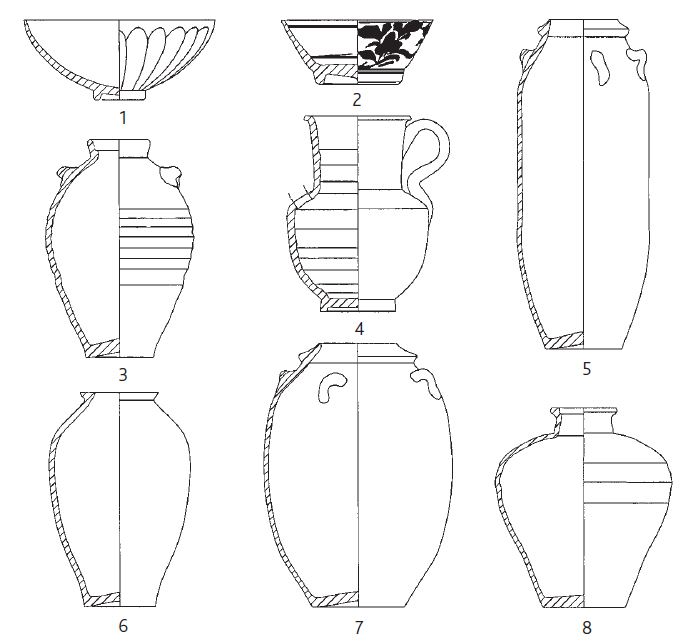
the Song to Qing dynasties near Dongjiao Village on Xiaolian Island in Pingtan
County. 1. Celadon wan-bowl (XLD:72) 2. Blue and white wan-bowl (XLD:103)
3. Celadon ping-vase (XLD:54) 4. Bluish-white zhihu-ewer (XLD:88) 5. Unglazed ping-vase (XLD:55) 6. Brown glaze ping-vase (XLD:84) 7. Brown glaze guan-jar with four lugs (XLD:05) 8. Brown glaze guan-jar (XLD:89) (scale 1:6)
Blue and white wan-bowl: Artifact XLD:103 has a square lip, flaring mouth and obliquely straight belly, and a ring foot, with the center of the exterior shaped like a papilla. It is fully glazed with bluish-gray glaze and has a scraped unglazed circle in the interior bottom, and has the glaze scraped at the bottom of its ring foot. Six sets of underglaze blue stylized flowers are painted on the exterior wall; flowers are painted in the inner center of the wan-bowl; a single underglaze blue line pattern is painted on both upper and lower parts of the interior wall. The underglaze blue shows bluish-gray color. Its mouth diameter is 13.5 cm, ring foot diameter 7.5 cm and height 6 cm (Figure 4:2).
Unglazed ping-vase: Artifact XLD:55 has a round lip, everted rim with a slightly concave surface, contracted mouth and sloped shoulder with four vertical bridge-shaped lugs and a slightly concave bottom. It has a reddish-brown body tempered with fine sand. Its mouth diameter is 6.1 cm, ring foot diameter 8 cm and height 30 cm (Figure 4:5).
The underwater cultural heritage remains in this site are rich and abundant. The artifacts recovered can be dated from the Song to Qing dynasties. These artifacts include not only products of Fujian kilns, but also products from kilns of Yixin City, Jiangsu Province and from Longquan kilns in Zhejiang Province. This proves that during the Song and Yuan dynasties, the Dalian and Xiaolian islands were “densely populated centers where merchant ships converged.”[5]
(E) Ming Dynasty Shipwreck Site Near Niushi Reef in Pingtan County
This site is located northwest of Haitan Island, and it is a shoal rock above the water. The seabed of the site has a flat bottom of soft silt. The survey team conducted investigations and recovered some artifacts from 2005 to 2008. Border authorities recovered a batch of artifacts originating from this site in 2005. Below is an introduction to these findings.
Artifacts recovered from this site are mainly blue and white porcelain, followed by a small number of white glaze and famille verte porcelain wares, etc. The main types are wan-bowls and pan-plates. These wares are not very well made, and most of them have slightly deformed mouths. The porcelain bodies are coarse, and the glaze shows a grayish undertone. Some artifacts are glazed to the exterior of the ring feet, but still lack glazing on the inner wall of the ring feet and the ends of the ring feet. Most of the glaze surfaces have pores and show crawling. Decorative patterns usually consist of flowers, running horses and people, etc. Blue color appears rather dark with grayish, bluish and blackish undertones.
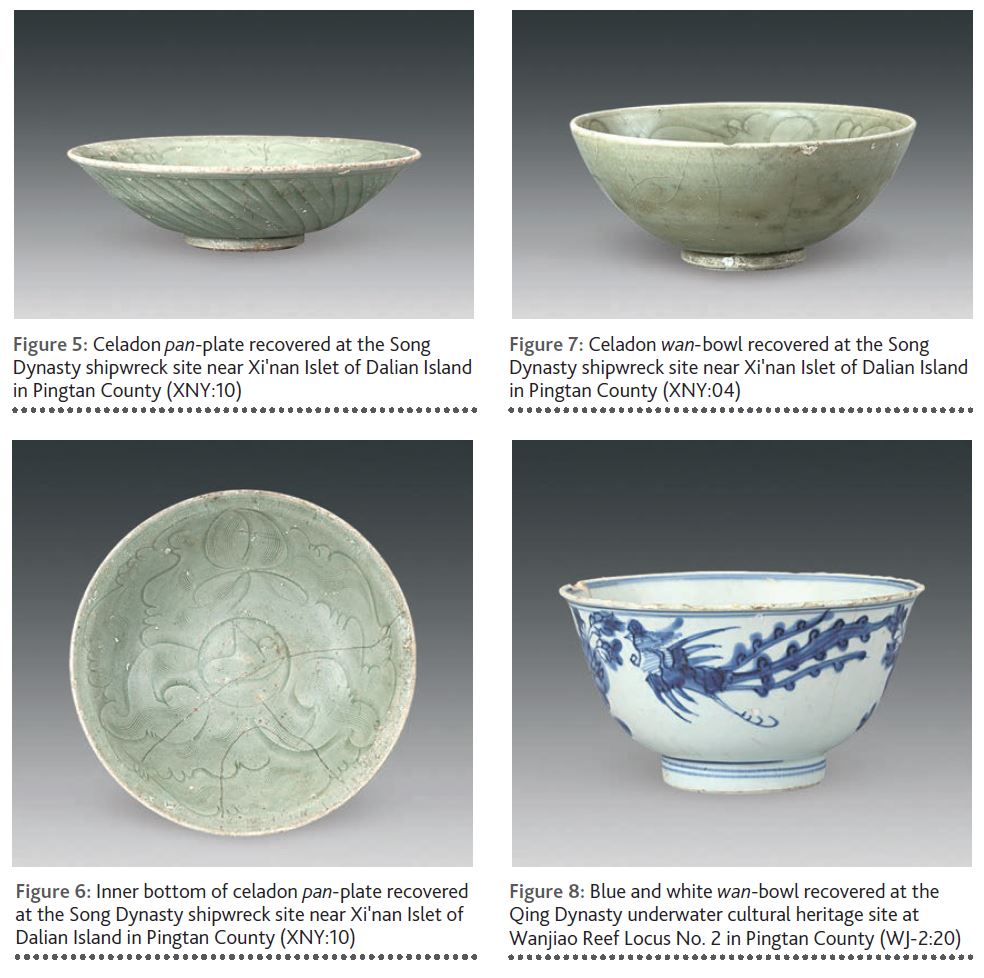
Blue and white wan-bowl: Artifact C1D (Defective):73.1 has a round lip, slightly everted mouth, slant arc belly and a ring foot. The underglaze blue shows a light gray color with a bluish undertone. A circle of double underglaze blue line pattern is painted on the interior bottom, enclosing painted maidens. A “children at play” design is painted on the exterior wall. The artifact’s mouth diameter is 14 cm, ring foot diameter 5.4 cm and height 6.2 cm (Figure 25:1). Artifact C1D:56.1 has a round lip, flaring mouth, slant arc belly and a ring foot with a narrow end. Its underglaze blue shows a grayish-blue color. A circle of double underglaze blue line pattern is painted on the interior bottom, enclosing painted flowers and leaves. Flowers and leaves are painted on the exterior wall. Its mouth diameter is 15 cm, ring foot diameter 6 cm and height 5.8 cm (Figure 25:2). Artifact C1D:53.1 has a sharp lip, everted mouth, slant arc belly and a ring foot. Its underglaze blue shows a grayish undertone and is slightly dark. A circle of double underglaze blue line pattern is painted on the interior bottom, enclosing stylized flowers. An interlocking lotus pattern is painted on the exterior wall. Its mouth diameter is 14.2 cm, ring foot diameter 5 cm and height 6.5 cm (Figure 15 and Figure 25:3). Artifact C1D:54.8 has a round lip, flaring mouth, slant arc belly and a ring foot. Its underglaze blue shows a pale blue color. A circle of double underglaze blue line pattern is painted on the interior bottom, enclosing a painted lotus and water ripple pattern. A band of lotus and water ripple pattern is painted on the exterior of the rim, and a banana leaf pattern is painted on the lower exterior wall. Its mouth diameter is 14 cm, ring foot diameter 4.9 cm and height 6.4 cm (Figure 16 and Figure 25:4). Artifact C1D:55.1 has a round lip, everted mouth, slant arc belly and a ring foot. Its underglaze blue shows a grayish undertone and is slightly dark. A circle of double underglaze blue line pattern is painted on the interior bottom, enclosing stylized flowers. An interlocking lotus pattern is painted on the exterior wall. Its mouth diameter is 17.7 cm, ring foot diameter 6.6 cm and height 7.6 cm (Figure 25:5). Artifact C1D:63.4 has a round lip, flaring mouth, slant arc belly and a ring foot. Its underglaze blue appears bluish-gray. A circle of double underglaze blue line pattern is painted on the interior bottom, enclosing stylized flowers. An interlocking lotus pattern is painted on the exterior wall. Its mouth diameter is 12.7 cm, ring foot diameter 4.4 cm and height 6.3 cm (Figure 25:6). Artifact C1D:65.2 has a sharp lip, everted mouth, slant arc belly and a ring foot. Its underglaze blue shows a bluish-gray color. A circle of double underglaze blue line pattern is painted on the interior bottom, enclosing a lotus pattern. A lotus pattern is painted on the exterior wall. Its mouth diameter is 13.8 cm, ring foot diameter 5.5 cm and height 6.2 cm (Figure 25:7). Artifact C1D:68.2 has a sharp lip, flaring mouth, slant arc belly and a ring foot. Its underglaze blue shows a pale blue color with a grayish undertone. A circle of double underglaze blue line pattern is painted on the interior bottom, enclosing a plum-blossom pattern. A magpie-and-plum-blossom pattern is painted on the exterior wall. Its mouth diameter is 16.2 cm, ring foot diameter 6.3 cm and height 5.5 cm (Figure 17 and Figure 25:8).
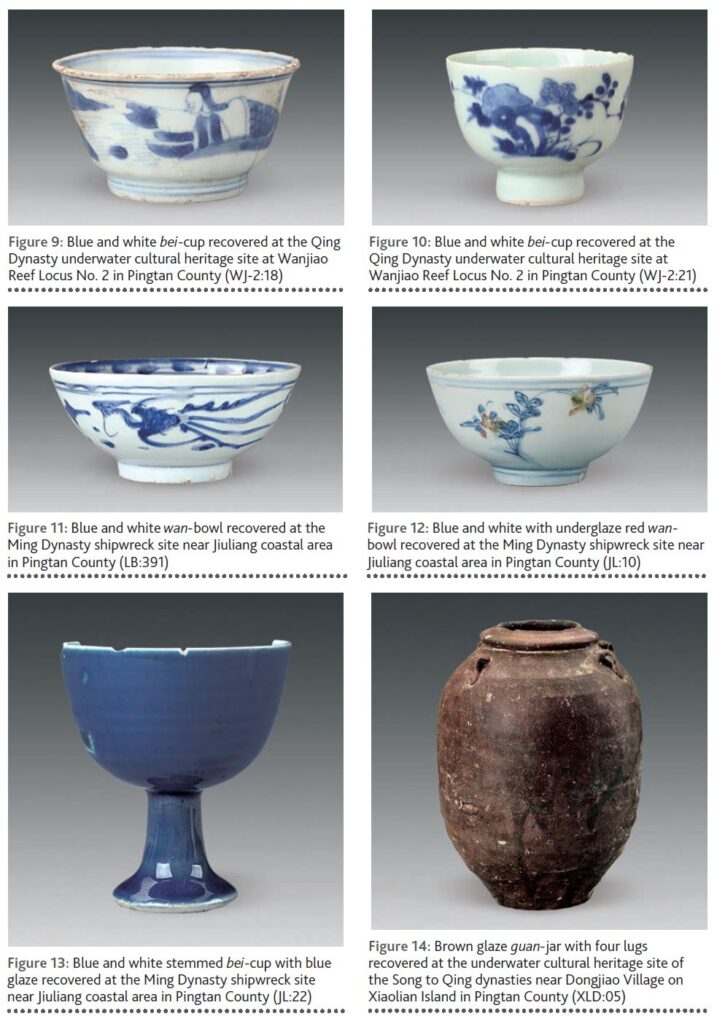
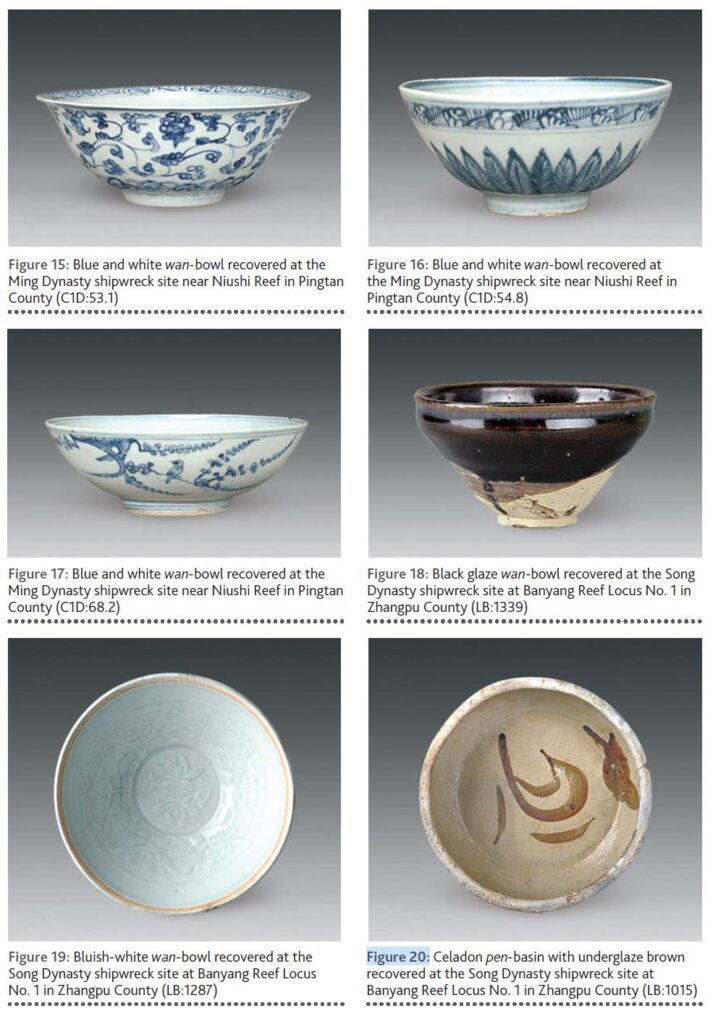
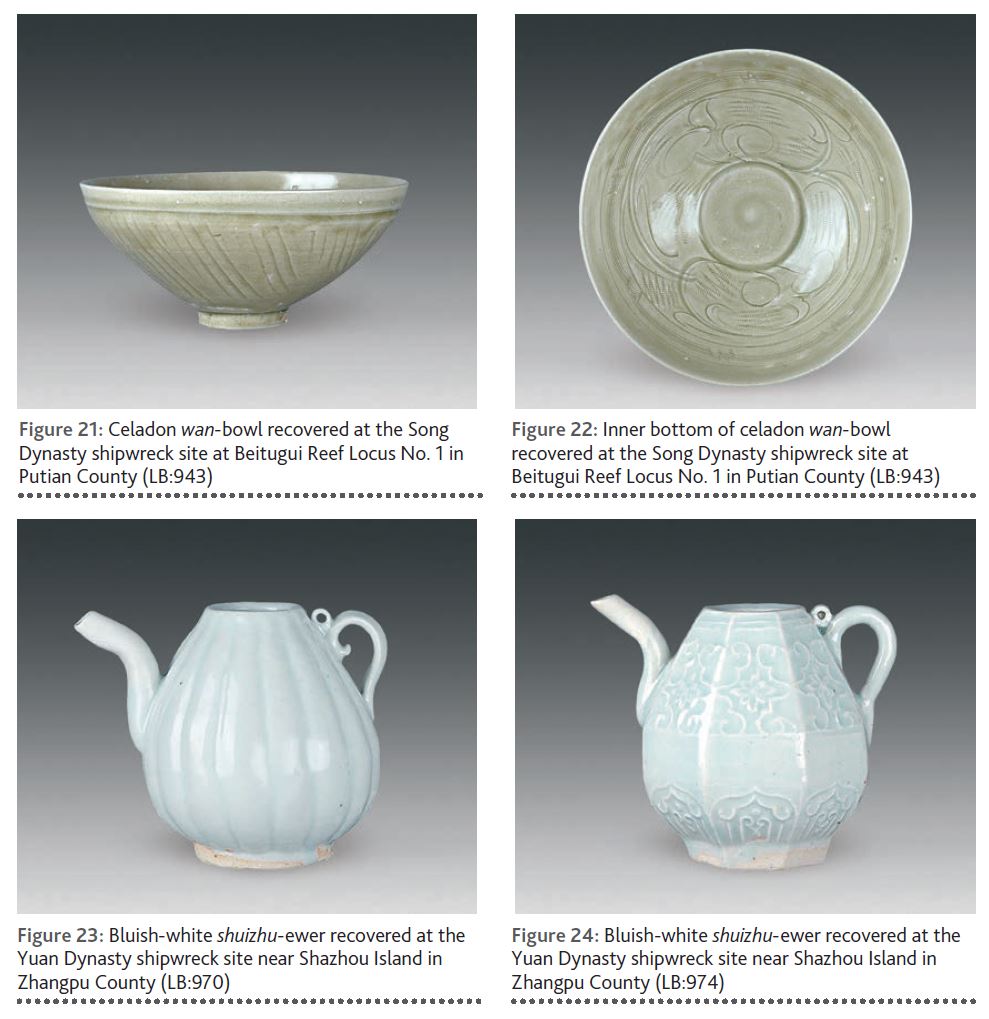
Blue and white pan-plate: Artifact C1D:79.1 has a round lip, flaring mouth, slant arc belly and a short ring foot. Its underglaze blue shows a gray color with a bluish undertone. A circle of double underglaze blue line pattern is painted on the interior bottom, enclosing a flower-and-leaf pattern. An interlocking flower-and-leaf pattern is painted on the exterior wall. The mouth diameter of the plate is 22.8 cm, ring foot diameter 14 cm and height 4.7 cm.
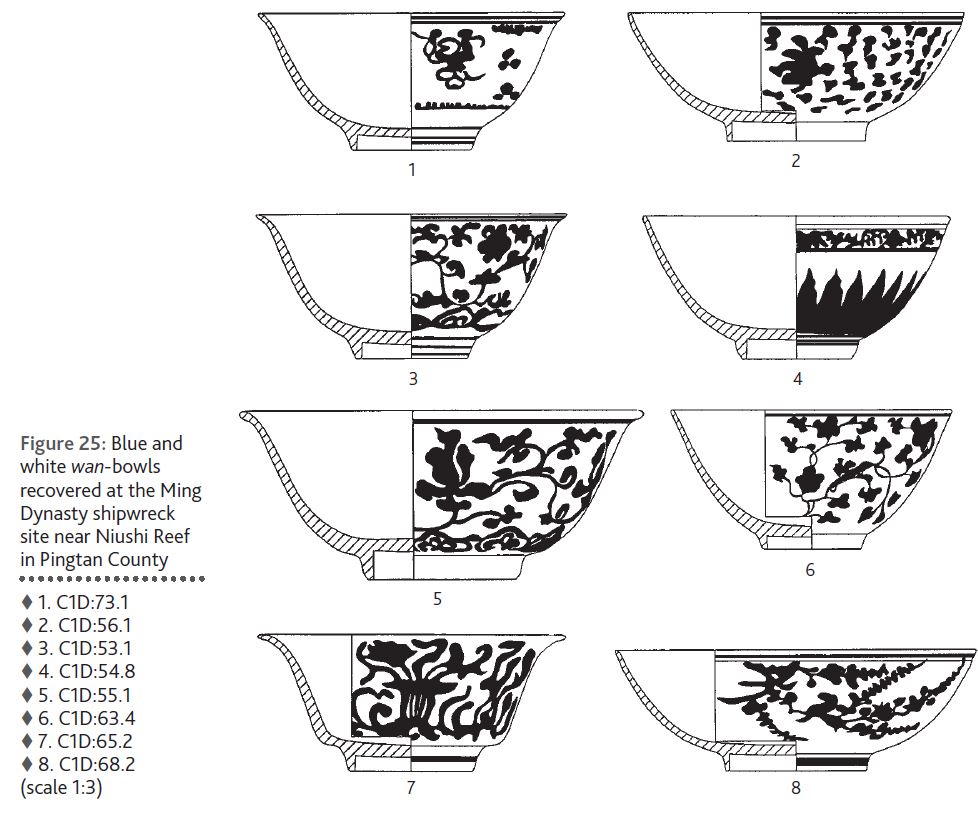
White glaze pan-plates: Artifact C1D:80.2 has a square lip, rhomboid flower mouth, wide everted rim, shallow slant arc belly and a ring foot. It is white glazed. The lower part of its exterior wall is mold-transferred with a chrysanthemum-petal pattern. Its mouth diameter is 24.1 cm, ring foot diameter 13.5 cm and height 3.9 cm. Artifact C1D:81.5 has a round lip, flaring mouth, slant arc belly and a ring foot. Its mouth diameter is 23.4 cm, ring foot diameter 13.6 cm and height 4.5 cm.
Famille verte pan-plate: Artifact C1D:82.5 has a round lip, flaring mouth, slant arc belly and a ring foot. Red and green color paintings on the outer bottom have worn off with only traces remaining. Its mouth diameter is 23.8 cm, ring foot diameter 13.1 cm and height 4.4 cm (Figure 29).
Based on their shape, form and decoration, and the cobalt used in the blue and white glazing, the artifacts recovered may be identified as products of Jingdezhen civilian kilns of the middle Ming Dynasty.
(F) Song Dynasty Shipwreck Site at Banyang Reef Locus No. 1 in Zhangpu County
This site is located north of Banyang Reef in the coastal area of the border of Longhai City and Zhangpu County. Banyang Reef is a submerged shoal rock; less than 1 m of it appears above water at low slack tide. The seabed in the area is silt, and the water depth is 19 m to 20 m at low tide. Cultural heritage remains are scattered over an area of more than 3,000 sq.m. This site was discovered in May 2010. The survey team conducted an investigation in October. Artifacts recovered consist of primarily porcelain wares, followed by a small number of lacquered and wooden wares, bronze wares, tin wares and bronze coins, etc. The porcelain wares consist of primarily black glaze wan-bowls, followed by a small number of greenish-white wan-bowls, pan-plates and die-saucers.
Black glaze wan-bowls: These wan-bowls have round lips, slightly contracted mouths, slant arc bellies with contracted lower parts and ring feet. Their body colors are mostly grayish-white, grayish-yellow or grayish-brown, etc. The surfaces of their glaze are typically shiny black, and show brownish undertone at the mouths and rims where the glaze is thin. The wan-bowls are fully glazed on their interior walls; on the exterior walls, glaze is only applied down to their lower bellies. Artifact BRL1 (Banyang Reef Locus No. 1):05 has a mouth diameter of 11.5 cm, ring foot diameter of 3.6 cm and height of 6.4 cm. Artifact BRL1:13 has a mouth diameter of 10.9 cm, ring foot diameter of 3.9 cm and height of 5.9 cm. Artifact LB:1303 has a hare’s fur pattern on the surface of its glaze. Its mouth diameter is 10.8 cm, ring foot diameter 3.6 cm and height 5.7 cm (Figure 30). Artifact LB:1339 has a mouth diameter of 11.2 cm, ring foot diameter of 3.7 cm and height of 6.5 cm (Figure 18).
Bluish-white wan-bowls: Artifact LB:1278 has a square lip, slightly everted mouth, slightly convex inner bottom and a short ring foot. It has a white body. It has a greenish-white glaze, some of which is cracked. It is fully glazed on the interior wall. On the exterior, glaze is applied only down to the lower part of the wall of its ring foot. The glaze on the rim is scraped. The interior has a mold-transferred image imprint depicting children at play. Its mouth diameter is 17.2 cm, ring foot diameter 4.4 cm and height 6 cm (Figure 26:2 and Figure 31). Artifact LB:1287 has a square lip, flaring mouth, relatively flat interior bottom, slightly convex exterior bottom and a ring foot with straight wall and flat end. It has a white body. It has a greenish-white glaze with cracks. It is fully glazed on the interior wall. On the exterior, glaze is applied only down to the bottom of the belly. The glaze near the rim is scraped. The middle section of the interior wall is imprinted with a mold-transferred band of labyrinth fret pattern with six framed panels below it. A mold-transferred flower-and-leaf pattern is imprinted inside the framed panels. The center of the interior bottom is imprinted with a mold-transferred lotus pattern. Its mouth diameter is 15.2 cm, ring foot diameter 4.3 cm and height 5.8 cm (Figure 19 and Figure 26:4).
Bluish-white pan-plate: Artifact LB:1290 has a square lip, flaring mouth, obliquely straight belly and a flat concave bottom. It has a grayish-white body, with greenish-white glaze that shows a grayish undertone. Its mouth diameter is 13.6 cm, ring foot diameter 8.4 cm and height 2.2 cm (Figure 26:1).
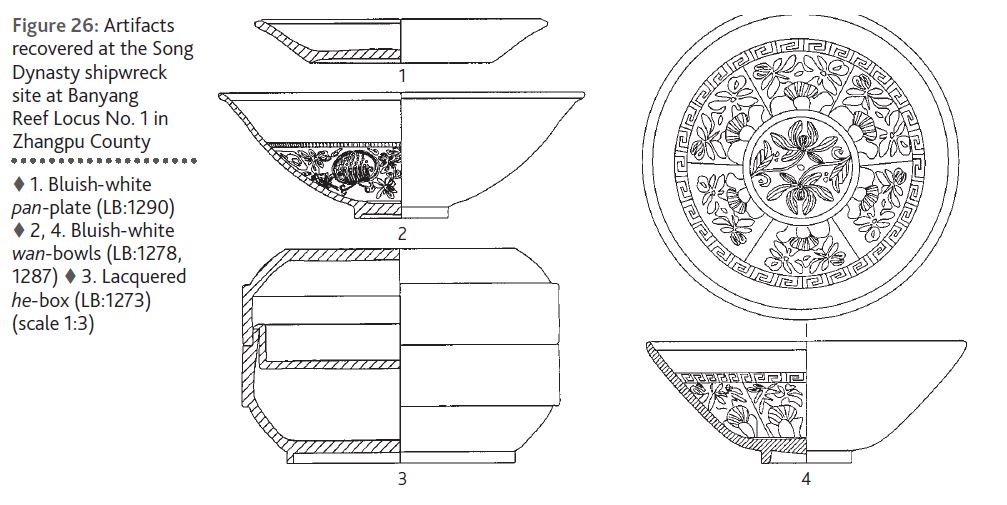
Celadon pen-basin with underglaze brown: Artifact LB:1015 has a round lip, contracted mouth, an everted rim, a shallow arc belly and a flat, slightly concave bottom. It has a gray body and greenish-gray glaze. It is fully glazed inside, with the rim and exterior wall unglazed. An underglaze brown leaf pattern is painted on the interior wall. There are eight marks of supporting pins on the rim. Its mouth diameter is 20.6 cm, ring foot diameter 15.2 cm and height 6.2 cm (Figure 20).
Lacquered he-box: Artifact LB:1273 is a set of three pieces. The he-box has an inside fitting mouth, straight upper and obliquely contracted lower belly, flat bottom and a ring foot. The lid of the he-box is outside fitting. It has a straight lower body, slant arc upper body and a flat top. The internal partition of the he-box has a straight wall and a flat bottom. The he-box is fully covered with bright shiny lacquer. The lid top diameter is 10.8 cm, the he-box ring foot diameter 10.6 cm and full height 10 cm (Figure 26:3).
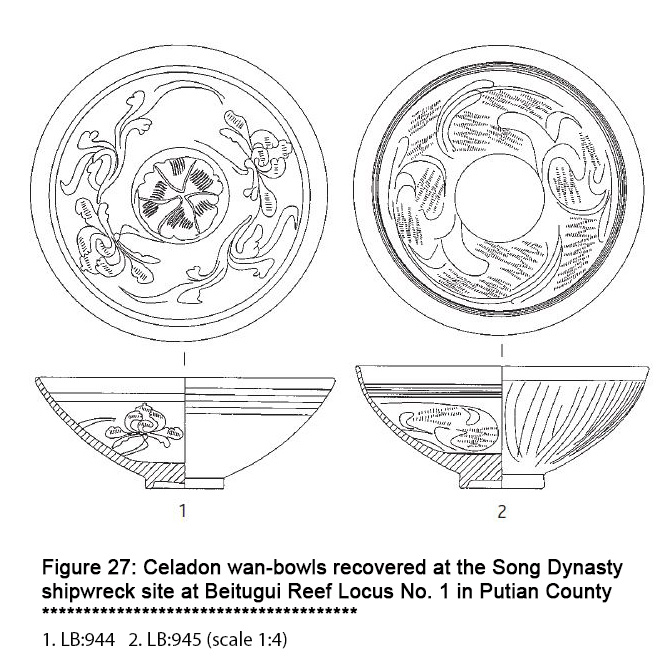
Among the artifacts recovered from this site, black glazed wan-bowls and celadon pen-basins with underglaze brown should be the products of kilns in Dongzhang Town of Fuqing City, and the greenish-white wan-bowls and pan-plates are similar to the products of kilns in Jianning County of Sanming City. Based upon these products and bronze coins recovered, this site should be dated to the middle to late Southern Song Dynasty.
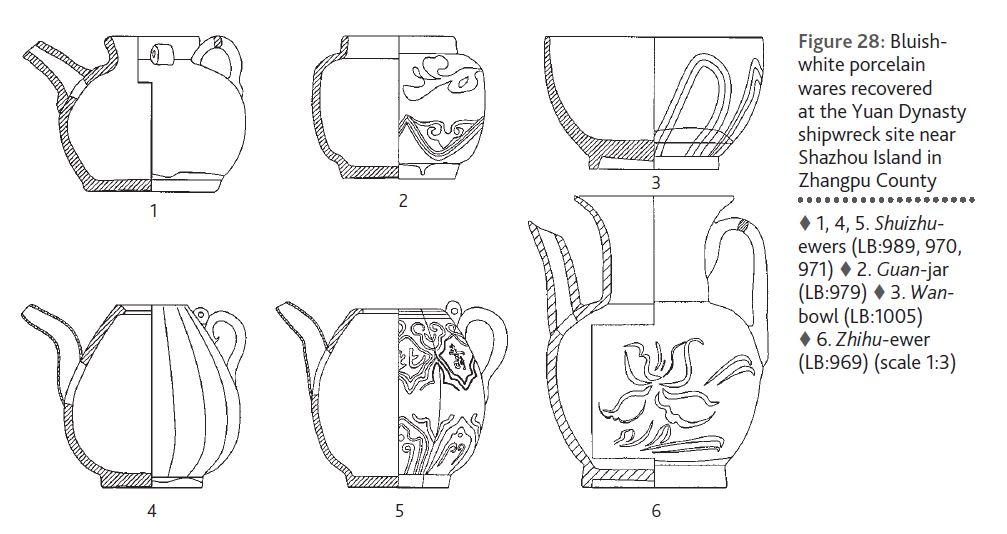
(G) Song Dynasty Shipwreck Site at Beitugui Reef Locus No. 1 in Putian County
This site is located about 300 m north of Beitugui [lit. “Northern Tortoise”] Reef in the coastal area of Nanri Island in Putian County, and was discovered in 2008. The water depth is 18 m at low slack tide, and the seabed is relatively flat with a silt-sand bottom. Artifacts are distributed over an area of about 5,000 sq.m. The remaining hull is not deeply buried, resting at a depth of around 0.2 m to 0.3 m, and is poorly preserved. The remaining hull components above the seabed are about 10 m long and about 1 m wide. The main types of recovered artifacts are celadon wan-bowls, pan-plates and bronze coins. In addition, two anchor stones were also discovered.[6]
Celadon wan-bowls: Artifact LB:943 has a round lip, a wide and slightly contracted mouth, slant arc belly and a ring foot. It has a gray body. Its interior is fully covered with dark greenish celadon glaze containing a grayish undertone, and its exterior has glaze applied to the lower wall of the ring foot. The interior wall is incised with a line pattern on the upper part and a grass-and-leaf pattern on the lower part; in the center it is decorated with a zigzag-lined grate-and-dot pattern. The exterior wall is incised with a line pattern on the upper part and a parallel-lined grate pattern on the lower part. Its mouth diameter is 17.3 cm, ring foot diameter 4.8 cm and height 7.4 cm (Figures 21 and 22). Artifact LB:944 has a round lip, flaring mouth, slant arc belly and a ring foot. It is glazed with celadon containing a grayish undertone. Its interior is fully covered with celadon glaze containing a grayish undertone, and its exterior has glaze applied to the lower wall of the ring foot. The interior wall is incised with a line pattern on the upper part and a lotus flower pattern on the lower part, and a medallion pattern on the inner bottom. Its mouth diameter is 18.4 cm, ring foot diameter 4.8 cm and height is 6.9 cm (Figure 27:1). Artifact LB:945 has a round lip, flaring mouth, slant arc belly and a ring foot. It has a dark greenish celadon glaze. The interior wall is incised with a line pattern on the upper part and a grass-and-leaf pattern on the lower part; in the center it is decorated with a zigzag-lined grate-and-dot pattern. The exterior wall is incised with a parallel-lined grate pattern. Its mouth diameter is 18 cm, ring foot diameter 5.2 cm and height 7.6 cm (Figure 27:2).
In the Excavation of Eastern Locus at Longquan Kiln Site [Longquan dongqu yaozhi fajue baogao龙泉东区窑址发掘报告], products from three clusters of kilns – Dabai’an kilns, Shantou kilns and Yuankou kilns – were divided into four phases and eight segments, and assigned dates ranging from the late Northern Song Dynasty to the middle Ming Dynasty. Porcelain artifacts recovered from this site resemble products of the second and the third of these segments and should therefore be dated to the early Southern Song Dynasty.
(H) Yuan Dynasty Shipwreck Site Near Shazhou Island in Zhangpu County
This site, discovered during an archaeological survey in 2008, is near Shazhou Island, east of Gulei Peninsula in Zhangpu County. Artifacts are distributed over an area of about 300 sq.m. over a sandy seabed. Recovered artifacts include celadon, greenish-white and brown glazed wares, etc. Types of wares include wan-bowls, zhan-cups, shuizhu-ewers, pen-basins, guan-jars, lu-censers and others. These porcelain artifacts are from the Jingdezhen kilns and other kilns in Fujian Province, dating to roughly the late Yuan and early Ming dynasties.[8]
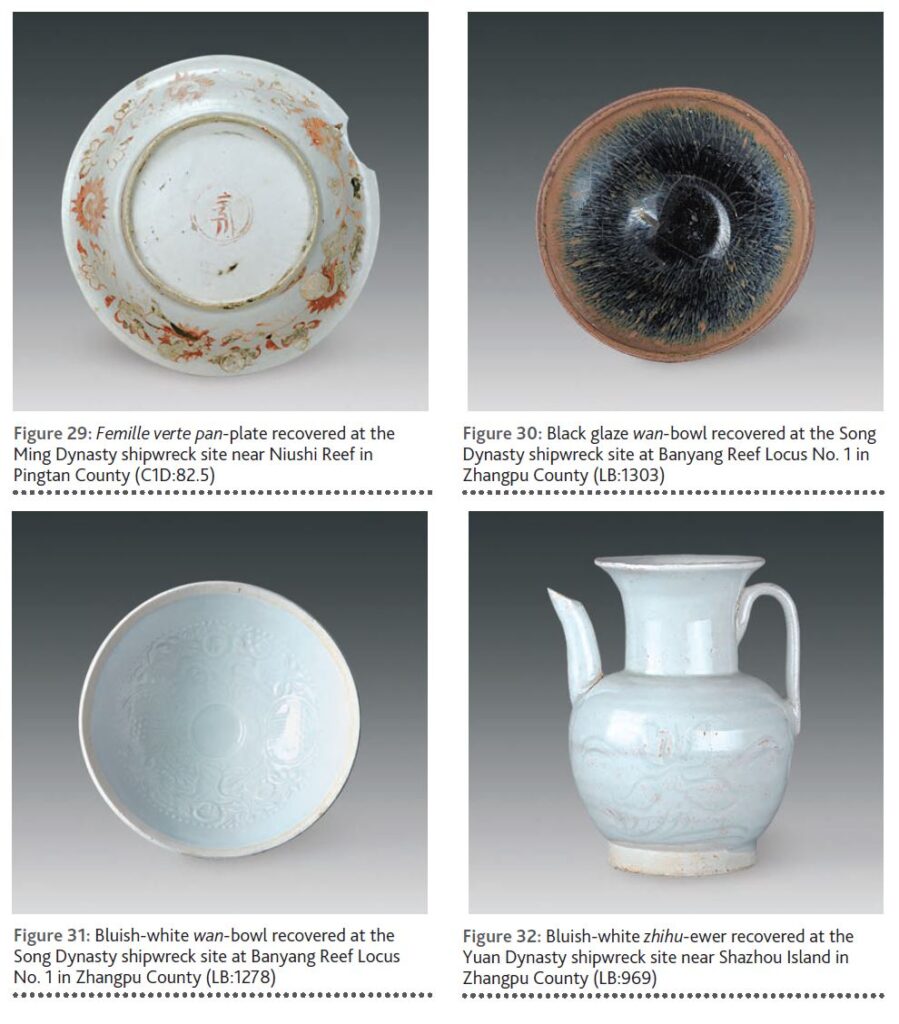
Bluish-white wan-bowl: Artifact LB:1005 has a round lip, slightly contracted mouth, arc belly, relatively flat inner bottom and slightly convex outer bottom. It has a gray body and is coated with greenish-white glaze containing a grayish undertone. Glaze is applied down to the lower belly. Lotus petals are incised on the exterior wall. Its mouth diameter is 10.5 cm, ring foot diameter 6.2 cm and height 6.4 cm (Figure 28:3).
Bluish-white zhihu-ewer: Artifact LB:969 has a sharp lip, everted mouth, waisted neck, round shoulder, arc belly, short ring foot, curved tuberous spout and a flat strip handle with two grooves. It has a white body with greenish-white glaze. The glaze is applied down to the upper neck area inside, and down to the upper part of the ring foot outside. A lotus-flower pattern is incised on the belly; a leaf pattern is incised on its spout and handle. Its mouth diameter is 7.6 cm, ring foot diameter 6.9 cm and height 14.2 cm (Figure 28:6 and Figure 32).
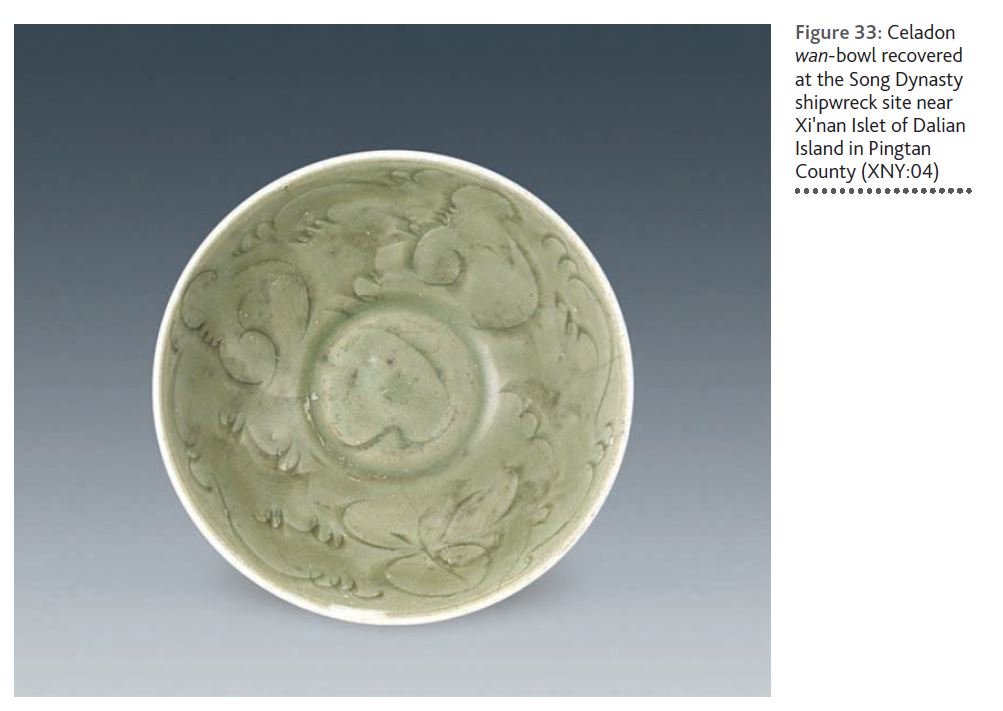
Bluish-white shuizhu-ewers: Artifact LB:970 has a round lip, contracted mouth, melon-shaped belly, shallow ring foot, curved tuberous spout and a flat strip handle. It has a white body. Greenish-white glaze is applied down to the upper belly inside and down to the lower belly outside. Its mouth diameter is 3.4 cm, ring foot diameter 4.8 cm and height 8.9 cm (Figure 23 and Figure 28:4). Artifact LB:971 has a square lip, contracted mouth, octagonal belly, false ring foot, curved tuberous spout, flat strip handle and a tuberous ring at its neck. A three-line pattern decorates the exterior of the rim. The upper body is inscribed with eight mold-transferred characters: 福如东海寿比南山 (fu ru donghai shou bi nanshan, meaning, “May you have fortune in the future and may you live a long and happy life”), and the lower belly has a mold-transferred lotus-petal pattern. Its mouth diameter is 3.5 cm, ring foot diameter 4.9 cm and height 8.7 cm (Figure 28:5). Artifact LB:974 has a round lip, contracted mouth, inward everted rim, octagonal belly, false ring foot, curved tuberous spout, flat strip handle and a tuberous ring at its neck. A double-convex-line pattern decorates the exterior of the rim. A rosettes pattern is mold-transferred onto the upper belly and a lotus-petal pattern is mold-transferred onto the lower belly. Its mouth diameter is 3.5 cm, ring foot diameter 4.5 cm and height 9 cm (Figure 24). Artifact LB:989 has a round lip, everted mouth, waisted neck, round shoulder, arc belly, flat and slightly concave bottom, curved tuberous spout, flat strip handle and a pair of tuberous rings at its neck. Its glaze is greenish-white containing a grayish undertone. Its glaze is applied down to the upper belly inside and down to the lower belly outside. Its mouth diameter is 4.6 cm, ring foot diameter 6.4 cm and height 7.5 cm (Figure 28:1).
Bluish-white guan-jar: Artifact LB:979 has a round lip, straight mouth, round shoulder, straight belly with a slight curve, contracted lower belly and a false ring foot. Its glaze is greenish-white, containing a grayish undertone. An interlocking flower pattern is mold-transferred onto the shoulder and upper belly, and a triangle pattern containing a ruyi-cloud-heap pattern is mold-transferred onto the lower belly. Its mouth diameter is 5.2 cm, ring foot diameter 5.3 cm and height 7 cm (Figure 28:2).
CONCLUSIONS
Above are some important discoveries from underwater archaeological explorations in the coastal area of Fujian Province since 2008. These underwater cultural heritage remains are located near maritime routes that are still in use and open to traffic; there are numerous reefs in the area and sea conditions are rather complicated. In-depth analysis of the locations of these underwater cultural heritage remains has great significance for the study of the ancient Maritime Silk Road of China.
The underwater cultural heritage remains in the coastal area of Fujian Province not only cover a long span of continuous, successful historical periods, but are also rich in cultural heritage content. Besides a large number of products from Fujian Province kilns, recovered porcelain products are also from Jingdezhen kilns, Longquan kilns, Yixing kilns and other kilns, which indicate that these Fujian Province coastal area sites play an important role in the study of ancient porcelain export routes and destinations. In addition, the shipwrecks have great value in research into ancient Chinese marine and shipbuilding technology.
_______________________________________
Photography: Hao Chen and Pengbo Song
Drawings: Zelin Yang and Jianguo Chen
Prepared by: Zelin Yang
_______________________________________
References Cited
- Local Gazetteer Compilation Committee of Pingtan County, Fujian Province. 2000. Pingtan xian zhi 平潭县志 (Gazetteer of Pingtan County), p. 81. Chronicle Press.
- Underwater Archaeological Team of Wanjiao Reef Site Locus No. 1. 2006. Donghai Pingtan Wanjiao yihao chushui ciqi 东海平潭碗礁一号出水瓷器 (Porcelain Wares Recovered in Wanjiao Reef Site Locus No.1 in Pingtan County, East China Sea), p. 20. Science Press.
- Underwater Archaeology Research Center in the National Museum of China. 2006. Xisha shuixia kaogu (1998-1999) 西沙水下考古 (1998-1999). (Underwater Archaeology in the Paracel Islands [aka Xisha Islands]: 1998–1999), p. 274. Science Press.
- Underwater Archaeological Survey Team for the Coastal Area of Fujian Province. 2010. “Fujian Pingtan Jiuliang I hao chenchuan yizhi shuixia kaogu diaocha jianbao” 福建平潭九梁Ⅰ号沉船遗址水下考古调查简报 (Summary Report of Underwater Archaeological Survey at Jiuliang Site Locus No. I Shipwreck in Pingtan County, Fujian Province). Fujian wenbo 福建文博 (Fujian Culture Heritage and Museums) No. 1.
- See [1], p. 67.
- Underwater Archaeological Survey Team for the Coastal Area of Fujian Province. 2009. “2008 nian Putian yanhai shuixia kaogu diaocha jianbao” 2008年莆田沿海水下考古调查简报 (Summary Report of Underwater Archaeological Survey Along the Coastal Area in Putian County in 2008). Fujian wenbo福建文博 (Fujian Culture Heritage and Museums) No. 2.
- Zhejiang Provincial Institute of Cultural Relics and Archaeology. 2005. Longquan dongqu yaozhi fajue baogao 龙泉东区窑址发掘报告 (Excavation at Eastern Zone of the Longquan Kiln Sites), p. 407. Cultural Relics Press.
- Underwater Archaeological Survey Team for the Coastal Area of Fujian Province. 2008. “Zhangpuxian Shazhoudao chenchuan yizhi shuixia kaogu diaocha” 漳浦县沙洲岛沉船遗址水下考古调查 (Underwater Archaeological Survey at Shipwreck Site Near Shazhou Island in Zhangpu County). Fujian wenbo 福建文博 (Fujian Culture Heritage and Museums) No. 2.
Wenwu (Cultural Relics) Editor: Xia Wang
Translated by Yuting Gao, MA, Archaeology and Museology, Minzu University of China, Beijing.
This article was originally published in Wenwu (Cultural Relics) No. 2, 2014, pp. 29-40.